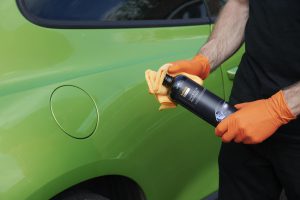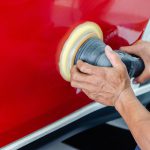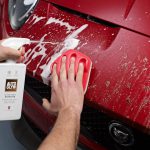Cars will naturally get dirty over time, but it’s not just standard road grime you need to worry about – other contaminants can be a lot harder to remove, and even leave lasting damage if you don’t take care of them properly.
Tree sap is a source of annoyance for many motorists, leaving your car sticky to the touch marring your paintwork. To help you with removing tree sap from your car, in this blog we’ll answer the following questions:
What does tree sap look like on a car?
Ever noticed a translucent, amber, sticky substance on your paintwork, maybe after parking under a tree? Yep, that’s tree sap.

It’s more common during the summer months when both deciduous and evergreen trees have flowing sap, but freshly cut branches, insect-infected trees, and tree debris carried by strong winds can also all lead to sap on your car.
How long does it take for tree sap to damage car paint?
There’s no fixed time period for damage to occur, but hardened tree sap is more likely to lead to marks than freshly fallen wet sap – this is partly because it can fuse to your paintwork, but the more common cause of marred or abrased paintwork when removing sap is misusing stronger chemical cleaners.
Stronger abrasive solvents and cleaners might cause damage to your paintwork if you aren’t using them correctly, so it’s important to read the instructions of your chosen product to ensure you don’t cause any accidental damage. Used as advised, you should be able to remove stubborn, hardened sap with no damage.
The best advice we can give you is to remove any signs of tree sap as soon as you spot them – this will minimize the risk of damage to your paintwork and make the job easier!
How to remove tree sap from car without damaging paint
If you’re removing tree sap that hasn’t hardened yet (it’s still wet and sticky to the touch), then the process is simple, and you shouldn’t need any specialist products – just a bit of extra elbow grease!
A thorough wash with your favourite shampoo and wash mitt should be sufficient for getting the sap off, with no risk of damage to your paintwork. If that doesn’t quite do the trick, then try upping the concentration of your shampoo and target the sap spot specifically. This extra cleaning power should usually suffice for removing any sticky residue or marks from wet sap.
However, hardened sap might need some specialised products to lift it without damage.
How to remove hardened tree sap from car
For more stubborn sap, a dedicated cleaner might be required. Don’t try to use nail polish remover, white spirit, or any other solvent cleaner that’s not specialised for use on a car, as it will usually do more damage.
There are several safe methods you can use to remove tree sap from car paintwork, depending on which you prefer.
A tar and glue remover is a fast-acting targeted cleaner and an easy way to lift stubborn stickiness from your paintwork, including tree sap. Or more experienced detailers might prefer using a clay bar – this decontamination method is used to lift all kinds of embedded contaminants as part of a thorough detail, to leave a smooth finish behind.

One of our favourite products is our Halfords Advanced Tar and Glue Remover, which is simple to use and perfect for lifting sticky and stubborn sap. Even better, it can be used on paintwork, glass, or metal surfaces, so you can treat any sap residue on your car’s other surfaces. Just apply it to a microfibre cloth and work over the contaminated area to lift the residue.
Using a clay bar can be a great way to ensure a smooth and shining surface ready for polishing and waxing, but it can take a little getting used to if you’ve not done it before. The key is to use a lubricating liquid to help the clay slide over your paintwork – this can be a dedicated lubricant, a water-based car detailer, or even a spray bottle of water mixed with a little car shampoo.
Some kits, such as the Autoglym Clay Surface Detailing Clay Kit, come with a lubricant spray included, but if you already have something suitable you can pick up a clay bar on its own, like the Halfords Clay Bar.
To begin, tear off a small piece of clay and work it in your hand until it’s malleable and flatten it into a circular shape, then spray your chosen lubricant onto the paintwork. Using light pressure, work the clay over the area and reapply the lubricant as needed. This should lift the sap and leave you with a smooth surface ready to wax.
How to prevent tree sap on car surfaces
Unfortunately, there’s not too much you can do to completely prevent any tree sap from getting onto your car. However, there are some steps you can take to minimise its impact.
The best solution is to regularly wash your car – getting into a wash routine will help to prevent any large build-ups of sap that become difficult to remove. Try to keep an eye out for any new sap deposits and clean them off as soon as possible.
We also recommend a protective wax, ceramic, or sealant layer – not only is this advisable for the general health and appearance of your paintwork, but a protective layer between the fresh paint and any sap will help to keep it from harming your vehicle.
That’s our guide to removing tree sap from car surfaces. It can be an annoyance but tackling it as soon as you spot any residue is the best way to prevent any damage.
If you need to boost your car cleaning arsenal, we’ve got you covered. Check out our range of car cleaning products online, or pop into your nearest store to talk through your options with one of our colleagues.


